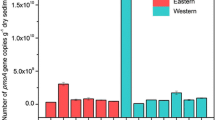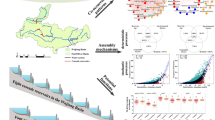Abstract
Significant spatial variation in CH4 emissions is a well-established feature of natural wetland ecosystems. To understand the key factors affecting CH4 production, the variation in community structure of methanogenic archaea, in relation to substrate and external environmental influences, was investigated in selected wetlands across China, using denaturing gradient gel electrophoresis. Case study areas were the subtropical Poyang wetland, the warm-temperate Hongze wetland, the cold-temperate Sanjiang marshes, and the alpine Ruoergai peatland on the Qinghai–Tibetan Plateau. The topsoil layer in the Hongze wetland exhibited the highest population of methanogens; the lowest was found in the Poyang wetland. Maximum CH4 production occurred in the topsoil layer of the Sanjiang Carex lasiocarpa marsh, the minimum was observed in the Ruoergai peatland. CH4 production potential was significantly correlated with the dissolved organic carbon (DOC) concentration but not with the abundance or diversity indices of methanogenic archaea. Phylogenetic analysis and DOC concentration indicated a shift in the dominant methanogen from the hydrogenotrophic Methanobacteriales in DOC-rich wetlands to Methanosarcinaceae with a low affinity in wetlands with relatively high DOC and then to the acetotrophic methanogen Methanosaetaceae with a high affinity in wetlands with low DOC, or with high DOC but rich sulfate-reducing bacteria. Therefore, it is proposed that the dominant methanogen type in wetlands is primarily influenced by available DOC concentration. In turn, the variation in CH4 production potential in the wetlands of eastern China is attributable to differences in the DOC content and the dominant type of methanogen present.





Similar content being viewed by others
References
Avery GB, Shannon RD, White JR, Martens CS, Alperin MJ (1999) Effect of seasonal changes in the pathways of methanogenesis on the δ13C values of pore water methane in a Michigan peatland. Glob Biogeochem Cycles 13:475–484
Avery GB, Shannon RD, White JR, Martens CS, Alperin MJ (2003) Controls on methane production in a tidal freshwater estuary and a peatland: methane production via acetate fermentation and CO2 reduction. Biogeochemistry 62:19–37
Barbosa MJ, Rocha JMS, Tramper J, WijGels RH (2001) Acetate as a carbon source for hydrogen production by photosynthetic bacteria. J Biotechnol 85:25–33
Bartlett KB, Crill PM, Sass RL, Harriss RC, Dise NB (1992) Methane emissions from tundra environments in the Yukon–Kuskokwim Delta, Alaska. J Geophys Res 97:16645–16660
Bloom AA, Palmer PI, Fraser A, Reay DSA, Frankenber C (2010) Large-scale controls of methanogenesis inferred from methane and gravity spaceborne data. Science 327:322–325
Cadillo-Quiroz H, Bräuer S, Yashiro E, Sun C, Yavitt J, Zinder S (2006) Vertical profiles of methanogenesis and methanogens in two contrasting acidic peatlands in central New York State, USA. Environ Microbiol 8:1428–1440
Cahyani VR, Murase J, Ikeda A, Taki K, Asakawa S, Kimura M (2008) Bacterial communities in iron mottles in the plow pan layer in a Japanese rice field: Estimation using PCR-DGGE and sequencing analyses. Soil Sci Plant Nutr 54:711–717
Chanton JP, Bauer JE, Glaser PA, Siegel DI, Kelley CA, Tyler SC, Romanowicz EH, Lazrus A (1995) Radiocarbon evidence for the substrates supporting methane formation within northern Minnesota peatlands. Geochim Cosmochim Acta 59:3663–3668
Chin KJ, Conrad R (1995) Intermediary metabolism in methanogenic paddy soil and the influence of temperature. FEMS Microbiol Ecol 18:85–102
Chin KJ, Lukow T, Conrad R (1999) Effect of temperature on structure and function of the methanogenic archaeal community in an anoxic rice field soil. Appl Environ Microbiol 65:2341–2349
Colwell FS, Boyd S, Delwiche ME, Reed DW, Phelps TJ, Newby DT (2008) Estimates of biogenic methane production rates in deep marine sediments at Hydrate Ridge, Cascadia Margin. Appl Environ Microbiol 74:3444–3452
Das D, Veziroğlu TN (2001) Hydrogen production by biological processes: a survey of literature. Int J Hydrogen Energy 26:13–28
Ding WX, Cai ZC, Tsuruta H, Li XP (2002) Effect of standing water depth on methane emissions from freshwater marshes in northeast China. Atmos Environ 36:5149–5157
Ding WX, Cai ZC, Tsuruta H (2005) Factors affecting seasonal variation of methane concentration in water in the freshwater marsh vegetated with Carex lasiocarpa. Biol Fertil Soils 41:1–8
Ding WX, Zhang YH, Cai ZC (2010) Impact of permanent inundation on methane emissions from a Spartina alterniflora coastal salt marsh. Atmos Environ 44:3894–3900
Duddleston KN, Kinney MA (2002) Anaerobic microbial biogeochemistry in a northern bog: acetate as a dominant metabolic end product. Glob Biogeochem Cycles 16:1063. doi:10.1029/2001GB001402
Fey A, Conrad R (2000) Effect of temperature on carbon and electron flow and on the archaeal community in methanogenic rice field soil. Appl Environ Microbiol 66:4790–4797
Frenzel P, Karofeld E (2000) CH4 emission from a hollow–ridge complex in a raised bog: the role of CH4 production and oxidation. Biogeochemistry 51:91–112
Galand PE, Saarnio S, Fritze H, Yrjälä K (2002) Depth related diversity of methanogen Archaea in Finnish oligotrophic fen. FEMS Microbiol Ecol 42:441–449
Galand PE, Fritze H, Yrjälä K (2003) Microsite-dependent changes in methanogenic populations in a boreal oligotrophic fen. Environ Microbiol 5:1133–1143
Galand PE, Fritze H, Conrad R, Yrjälä K (2005) Pathways for methanogenesis and diversity of methanogenic archaea in three boreal peatland ecosystems. Appl Environ Microbiol 71:2195–2198
Glaser PH, Janssens JA, Siegel DI (1990) The response of vegetation to chemical and hydrological gradients in the Lost River peatland, northern Minnesota. J Ecol 78:1021–1048
Grbic-Galic D (1986) Anaerobic production and transformation of aromatic hydrocarbons and substituted phenols by ferulic acid-degrading BESA-inhibited methanogenic consortia. FEMS Microbiol Lett 38:161–169
Grbic-Galic D, Young LY (1985) Methane fermentation of ferulate and benzoate: anaerobic degradation pathways. Appl Environ Microbiol 50:292–297
Griffin ME, McMahon KD, Mackie RI, Raskin L (1998) Methanogenic population dynamics during start-up of anaerobic digesters treating municipal solid waste and biosolids. Biotechnol Bioeng 57:342–355
Høj L, Olsen RA, Torsvik VL (2005) Archaeal communities in High Arctic wetlands at Spitsbergen, Norway (78°N) as characterized by 16SrRNA gene fingerprinting. FEMS Microbiol Ecol 53:89–101
Horn MA, Matthies C, Küsel K, Schramm A, Drake HL (2003) Hydrogenotrophic methanogenesis by moderately acid-tolerant methanogens of a methane-emitting acidic peat. Appl Environ Microbiol 69:74–83
International Panel on Climate Change (IPCC) (2007) Climate change 2007: the physical science basis. Oxford University Press, Cambridge
Jetten MSM, Stams AJM, Zehnder AJB (1990) Acetate threshold values and acetate activating enzymes in methanogenic bacteria. FEMS Microbiol Ecol 73:339–344
Jetten MSM, Stams AJM, Zehnder AJB (1992) Methanogenesis from acetate: a comparison of the acetate metabolism in Methanothrix soehngenii and Methanosarcina spp. FEMS Microbiol Rev 88:181–197
Jia ZJ, Conrad R (2009) Bacteria rather than archaea dominate microbial ammonia oxidation in an agricultural soil. Environ Microbiol 11:1658–1671
Jo JH, Jeon CO, Lee DS, Park JM (2007) Process stability and microbial community structure in anaerobic hydrogen-producing microflora from food waste containing kimchi. J Biotechnol 131:300–308
Juottonen H, Galand PE, Tuittila ES, Laine J, Fritze H, Yrjälä K (2005) Methanogen communities and Bacteria along an ecohydrological gradient in a northern raised bog complex. Environ Microbiol 7:1547–1557
Juottonen H, Tuittila ES, Juutinen S, Fritze H, Yrjälä K (2008) Seasonality of rDNA- and rRNA-derived archaeal communities and methanogenic potential in a boreal mire. ISME J 2:1157–1168
King JY, Reeburgh WS (2002) A pulse-labeling experiment to determine the contribution of recent plant photosynthates to net methane emission in arctic wet sedge tundra. Soil Biol Biochem 34:173–180
Koelbener A, Ström L, Edwards PJ, Venterink HO (2010) Plant species from mesotrophic wetlands cause relatively high methane emissions from peat soil. Plant Soil 326:147–158
Kotsyurbenko OR, Chin KJ, Glagolev MV, Stubner S (2004) Acetoclastic and hydrogenotrophic methane production and methanogenic populations in an acidic West-Siberian peat bog. Environ Microbiol 6:1159–1173
Leschine SB (1995) Cellulose degradation in anaerobic environments. Annu Rev Microbiol 49:399–426
Leybo AI, Netrusov AI, Conrad R (2006) Effect of hydrogen concentration on the community structure of hydrogenotrophic methanogens studied by T-RELP analysis of 16S rRNA gene amplicons. Microbiology 75:786–791
Liu DY, Ding WX, Jia ZJ, Cai ZC (2011) Relation between methanogenic archaea and methane production potential in selected natural wetland ecosystems across China. Biogeosciences 8:329–338
Mao XY, Miyake J, Kawamura S (1986) Screening photosynthetic bacteria for hydrogen production from organic acids. J Ferment Technol 64:245–249
Melling L, Hatano R, Goh KJ (2005) Methane fluxes from three ecosystems in tropical peatland of Sarawak, Malaysia. Soil Biol Biochem 37:1445–1453
Metje M, Frenzel P (2005) The effect of temperature on anaerobic ethanol oxidation and methanogenesis in an acidic peat from a northern wetland. Appl Environ Microbiol 71:8191–8200
Miyake J, Mao XY, Kawamura S (1984) Photoproduction of hydrogen from glucose by a co-culture of a photosynthetic bacterium and Clostridium butyricum. J Ferment Technol 62:531–535
Oh YK, Seol EH, Kimc MS, Parka S (2004) Photoproduction of hydrogen from acetate by a chemoheterotrophic bacterium Rhodopseudomonas palustris P4. Int J Hydrogen Energy 29:1115–1121
Peng JJ, Lü Z, Rui JP, Lu YH (2008) Dynamics of the methanogenic archaeal community during plant residue decomposition in an anoxic rice field soil. Appl Environ Microbiol 74:2894–2901
Rooney-Varga JN, Giewat MW, Duddleston KN, Chanton JP, Hines ME (2007) Links between archaeal community structure, vegetation type and methanogenic pathway in Alaskan peatlands. FEMS Microbiol Ecol 60:240–251
Saarnio S, Alm J, Martikainen PJ, Silvola J (1998) Effects of raised CO2 on potential CH4 production and oxidation in, and CH4 emission from, a boreal mire. J Ecol 86:261–268
Smith KS, Ingram-Smith C (2007) Methanosaeta, the forgotten methanogen? Trends Microbiol 15:150–155
Ström L, Ekberg A, Mastepanov M, Christensen TR (2003) The effect of vascular plants on carbon turnover and methane emissions from a tundra wetland. Glob Chang Biol 9:1185–1192
Ström L, Mastepanov MT, Christensen R (2005) Species-specific effects of vascular plants on carbon turnover and methane emissions from wetlands. Biogeochemistry 75:65–82
Verville JH, Hobbie SE, Chapin FSI, Hooper DU (1998) Response of tundra CH4 and CO2 flux to manipulation of temperature and vegetation. Biogeochemistry 41:215–235
Wang ZP, Han XG (2005) Diurnal variation in methane emissions in relation to plants and environmental variables in the Inner Mongolia marshes. Atmos Environ 39:6295–6305
Watanabe T, Kimura M, Asakawa S (2006) Community structure of methanogenic archaea in paddy field soil under double cropping (rice–wheat). Soil Biol Biochem 38:1264–1274
Watanabe T, Kimura M, Asakawa S (2007) Dynamics of methanogenic archaeal communities based on rRNA analysis and their relation to methanogenic activity in Japanese paddy field soils. Soil Biol Biochem 39:2877–2887
Watanabe T, Cahyani VR, Murase J, Ishibashi E, Kimura M, Asakawa S (2009) Methanogenic archaeal communities developed in paddy fields in the Kojima Bay polder, estimated by denaturing gradient gel electrophoresis, real-time PCR and sequencing analyses. Soil Sci Plant Nutr 55:73–79
Westermann P (1993) Temperature regulation of methanogenesis in wetlands. Chemosphere 26:321–328
Whiting GJ, Chanton JP (1993) Primary production control of methane emission from wetlands. Nature 364:794–795
Whitman WB, Bowen TL, Boone DR (1992) The methanogenic bacteria. In: Dworkin M et al (eds) The Prokaryotes: an evolving electronic resource for the microbiological community. Release 3.0. Springer, New York
Zhang GS, Tian JQ, Jiang N, Guo XP, Wang YF, Dong XZ (2008) Methanogen community in Zoige wetland of Tibetan plateau and phenotypic characterization of a dominant uncultured methanogen cluster ZC-I. Environ Microbiol 10:1850–1860
Zhao KY (1999) Mires in China. Science, Beijing (In Chinese)
Zhu XJ (1991) The explanations of formation and named time about Hongze. J Huaiyin Teach Coll 3:125–126 (In Chinese)
Acknowledgments
We would like to thank Dan Zhu in the Chengdu Institute of Biology and Yanyu Song and Lili Wang in the Northeast Institute of Geography and Agroecology, Chinese Academy of Sciences for their practical help on the collection of soil samples. We would also like to extend our thanks to Youzhi Feng and Yongchang Yu of the Institute of Soil Science, Chinese Academy of Sciences for their help on the experiments of DGGE. This work was supported by the Chinese Academy of Sciences (KZCX2-YW-439), the Natural Science Foundation of China (40725003, 40921061, 41001045), and the Natural Science Foundation of Jiangsu province (BK2008057).
Author information
Authors and Affiliations
Corresponding author
Rights and permissions
About this article
Cite this article
Liu, D., Ding, W., Jia, Z. et al. The impact of dissolved organic carbon on the spatial variability of methanogenic archaea communities in natural wetland ecosystems across China. Appl Microbiol Biotechnol 96, 253–263 (2012). https://doi.org/10.1007/s00253-011-3842-x
Received:
Revised:
Accepted:
Published:
Issue Date:
DOI: https://doi.org/10.1007/s00253-011-3842-x




